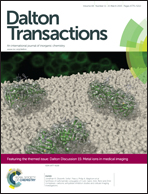Bifunctional 64Cu-labelled macrobicyclic cage amine isothiocyanates for immuno-positron emission tomography†
Abstract
New macrobicyclic cage amine or “sarcophagine” (sar) bifunctional chelators have been synthesised that form copper complexes of exceptional in vivo stability and incorporate isothiocyanate (-NCS) functional groups for conjugation to an antibody. The chelators were synthesised from the methyl-capped complex [MgII(CH3)(NH2)sar]2+. Coordination of MgII within the cavity of the cage amine ligand protects the secondary amine atoms from reacting with the -NCS functional groups. Two different [MgII(NCS-sar)]2+ derivatives were conjugated to the HER2/neu-targeting antibody trastuzumab and the progress of the reaction monitored by electrospray mass spectrometry. The MgII ion was removed from the immunoconjugates under mild conditions (0.1 M citrate buffer, pH 6). Labelling of the (CH3)(p-NCS-Ph)sar-trastuzumab conjugate with 64CuII, a radioisotope suitable for positron emission tomography (PET), was fast (∼5 min) and easily performed at room temperature with high radiochemical purity (>95%). Biodistribution and PET imaging studies in vivo showed that 64Cu-labelled (CH3)(p-NCS-Ph)sar-trastuzumab maintained high stability under physiological conditions with high and selective uptake in a HER2-positive cancer cell line. The stability of the copper complex and the 12.7 h half-life of the radioisotope allows clear visualisation of tumours out to 48 h.

- This article is part of the themed collection: Dalton Discussion 15: Metal ions in medical imaging

 Please wait while we load your content...
Please wait while we load your content...